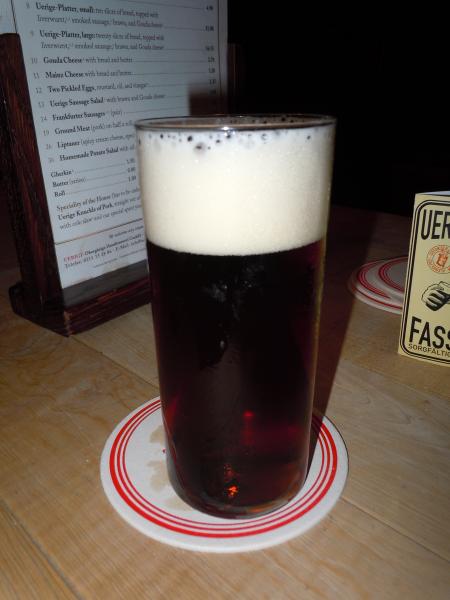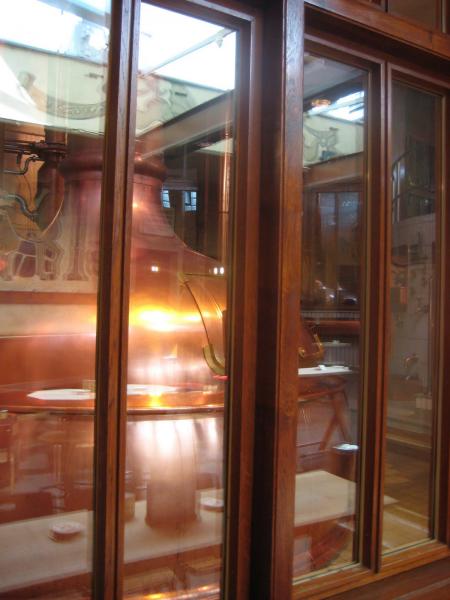I have done quite a bit of research on altbier, including Ray Daniel's book, J.Z.'s book and podcast concerning the style, and anything else I could get my hands on including a Michael Jackson article and I even found a (purported) clone of Zum Uerige.
It seems that generally modern breweries and homebrewers are using pilsner malt as a base malt. Industrial breweries are using something like 10% Munich malts and 90% Pilsener malts, with maybe some caramel malts and dark malts to adjust for color. Homebrewers seem to add a dash of caramunich and huskless carafa to the same effect (Daniels chapter 14, esp. 130-131).
Here's what I am confused about, and it sort of involves the seemingly endless variety of Munich malts out there. If you put together a grist of 90% Pilsener and 10% Munich (whether of the 5.5 L, 10L or 20L variety) you get nowhere near the right color for an alt. More like 3-4 SRM than 11-19 SRM which is the range for the alts as a whole. Apparently, some brewers add caramel coloring, or used to do this more often, until the debittered dark malts became available for color adjustment. The question is: why?
To make it darker, yes, but why bother making it appear darker unless there was already a tradition of it being in that color range to begin with? Those debittered dark malts won't add much flavor. They are really just meant for color adjustment. And if such a tradition of 11-19 SRM ales existed prior to this artificial coloring, how was the color originally obtained? I expect it had something to do with a now-extinct brewing or malting method, but I can't find any information.
There are a few possibilities. The first is the use of a dark Munich malt (like Belgian Dark Munich Malt at around 10L) which should still be self-converting, while contributing the right color. Alternatively, the base beer might have been pretty light, with some kind of darker malt added in lower frequencies. But I can't figure out for the life of me why it would have changed and brewers would have used caramel to color the beer to simulate the proper appearance.
At the same time, I'm pretty confused by the different Munich malts. There's the German Munich base malt of 5.5L, then there are three German CaraMunichs. And that's not to mention that in the US we have a 10L and 20L Munich malt. Of the three, 5.5, 10, and 20, which is the more traditional base malt? Are 10 and 20 just slightly roasted versions of 5.5? I have a sneaking suspicion that the original alt base malt wasn't Pilsener (at least not everywhere) but was rather a 'Munich' malt. But then, I'm not even really sure I understand the difference between Munich and Pilsner in biological or malting terms. Or Vienna for that matter.
Is there a good resource for understanding those German malts on more than a deeper level?
And what was altbier like in 1700? Why did brewers begin adding caramel for color? Were they simulating something else? What was the something else? Was Pilsner always the traditional base malt?
I'm so confused.
It seems that generally modern breweries and homebrewers are using pilsner malt as a base malt. Industrial breweries are using something like 10% Munich malts and 90% Pilsener malts, with maybe some caramel malts and dark malts to adjust for color. Homebrewers seem to add a dash of caramunich and huskless carafa to the same effect (Daniels chapter 14, esp. 130-131).
Here's what I am confused about, and it sort of involves the seemingly endless variety of Munich malts out there. If you put together a grist of 90% Pilsener and 10% Munich (whether of the 5.5 L, 10L or 20L variety) you get nowhere near the right color for an alt. More like 3-4 SRM than 11-19 SRM which is the range for the alts as a whole. Apparently, some brewers add caramel coloring, or used to do this more often, until the debittered dark malts became available for color adjustment. The question is: why?
To make it darker, yes, but why bother making it appear darker unless there was already a tradition of it being in that color range to begin with? Those debittered dark malts won't add much flavor. They are really just meant for color adjustment. And if such a tradition of 11-19 SRM ales existed prior to this artificial coloring, how was the color originally obtained? I expect it had something to do with a now-extinct brewing or malting method, but I can't find any information.
There are a few possibilities. The first is the use of a dark Munich malt (like Belgian Dark Munich Malt at around 10L) which should still be self-converting, while contributing the right color. Alternatively, the base beer might have been pretty light, with some kind of darker malt added in lower frequencies. But I can't figure out for the life of me why it would have changed and brewers would have used caramel to color the beer to simulate the proper appearance.
At the same time, I'm pretty confused by the different Munich malts. There's the German Munich base malt of 5.5L, then there are three German CaraMunichs. And that's not to mention that in the US we have a 10L and 20L Munich malt. Of the three, 5.5, 10, and 20, which is the more traditional base malt? Are 10 and 20 just slightly roasted versions of 5.5? I have a sneaking suspicion that the original alt base malt wasn't Pilsener (at least not everywhere) but was rather a 'Munich' malt. But then, I'm not even really sure I understand the difference between Munich and Pilsner in biological or malting terms. Or Vienna for that matter.
Is there a good resource for understanding those German malts on more than a deeper level?
And what was altbier like in 1700? Why did brewers begin adding caramel for color? Were they simulating something else? What was the something else? Was Pilsner always the traditional base malt?
I'm so confused.















































![Craft A Brew - Safale S-04 Dry Yeast - Fermentis - English Ale Dry Yeast - For English and American Ales and Hard Apple Ciders - Ingredients for Home Brewing - Beer Making Supplies - [1 Pack]](https://m.media-amazon.com/images/I/41fVGNh6JfL._SL500_.jpg)



















